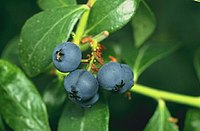
Photo from wikipedia
Abstract Field fertilization experiments with black currants have given inconsistent and often nonsignificant results. Therefore, we used an experimental system with single-stemmed plants grown in pots and fertilized by controlled… Click to show full abstract
Abstract Field fertilization experiments with black currants have given inconsistent and often nonsignificant results. Therefore, we used an experimental system with single-stemmed plants grown in pots and fertilized by controlled trickle fertigation during both the period of flower formation in autumn and during berry development to study fertilization effects in black currants. Continuation of nutrient supply until mid-September, or a one-week pulse of generous supply in early September delayed growth cessation and floral initiation, and increased total flowering and berry yield in the following season. Such autumn fertilization did not adversely affect plant winter survival and growth vigour in the spring. Berry yield and fruit size also increased with increasing nutrient supply during fruit development in cultivars ‘Ben Tron’ and ‘Narve Viking’, while they were unaffected in ‘Hedda’ and decreased with increasing supply in the high-arctic ‘Imandra’. However, berry dry matter and the concentration of soluble solids and a range of health-related chemical constituents decreased with increasing nutrient supply in all cultivars. This was mainly a dilution effect related to increases in berry size. Yield potential and berry concentrations of nutritionally related chemical constituents varied significantly between the cultivars, being generally highest in ‘Ben Tron’ and ‘Narve Viking’, and lowest in ‘Hedda’. Leaf macro-mineral content at harvest time increased with increasing nutrient supply, but varied markedly between the cultivars. While ‘Imandra’ had higher leaf concentration of N than the other cultivars, ‘Ben Tron’ had remarkably low concentrations of K, as also reported in other investigations. The recommended range of leaf K content is therefore imprecise as a basis for fertilization of this cultivar. The results are discussed and we conclude that the present experimental system has clear advantages over traditional, long-term field experiments. We further conclude that black currants should preferentially be fertilized in early autumn, immediately after berry harvest, as this will enhance flower formation and subsequent berry yield without adversely affecting berry concentrations of important fruit quality constituents.
Journal Title: Scientia Horticulturae
Year Published: 2017
Link to full text (if available)
Share on Social Media: Sign Up to like & get
recommendations!